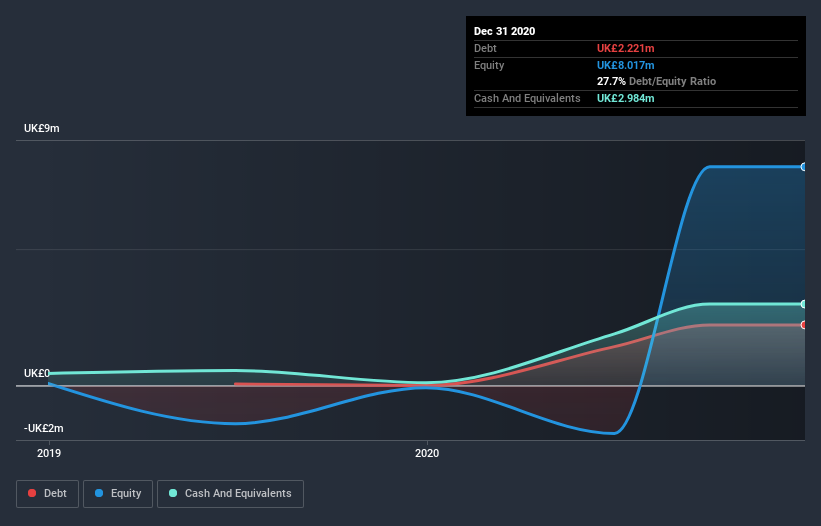Is eEnergy Group (LON:EAAS) Using Too Much Debt?
Howard Marks put it nicely when he said that, rather than worrying about share price volatility, 'The possibility of permanent loss is the risk I worry about... and every practical investor I know worries about.' When we think about how risky a company is, we always like to look at its use of debt, since debt overload can lead to ruin. We note that eEnergy Group Plc (LON:EAAS) does have debt on its balance sheet. But the more important question is: how much risk is that debt creating?
What Risk Does Debt Bring?
Debt and other liabilities become risky for a business when it cannot easily fulfill those obligations, either with free cash flow or by raising capital at an attractive price. Part and parcel of capitalism is the process of 'creative destruction' where failed businesses are mercilessly liquidated by their bankers. However, a more usual (but still expensive) situation is where a company must dilute shareholders at a cheap share price simply to get debt under control. By replacing dilution, though, debt can be an extremely good tool for businesses that need capital to invest in growth at high rates of return. When we examine debt levels, we first consider both cash and debt levels, together.
View our latest analysis for eEnergy Group
How Much Debt Does eEnergy Group Carry?
You can click the graphic below for the historical numbers, but it shows that as of December 2020 eEnergy Group had UK£2.22m of debt, an increase on none, over one year. But on the other hand it also has UK£2.98m in cash, leading to a UK£763.0k net cash position.
A Look At eEnergy Group's Liabilities
Zooming in on the latest balance sheet data, we can see that eEnergy Group had liabilities of UK£9.06m due within 12 months and liabilities of UK£2.68m due beyond that. On the other hand, it had cash of UK£2.98m and UK£3.55m worth of receivables due within a year. So it has liabilities totalling UK£5.20m more than its cash and near-term receivables, combined.
Given eEnergy Group has a market capitalization of UK£64.0m, it's hard to believe these liabilities pose much threat. But there are sufficient liabilities that we would certainly recommend shareholders continue to monitor the balance sheet, going forward. While it does have liabilities worth noting, eEnergy Group also has more cash than debt, so we're pretty confident it can manage its debt safely. When analysing debt levels, the balance sheet is the obvious place to start. But it is future earnings, more than anything, that will determine eEnergy Group's ability to maintain a healthy balance sheet going forward. So if you want to see what the professionals think, you might find this free report on analyst profit forecasts to be interesting.
In the last year eEnergy Group managed to produce its first revenue as a listed company, but given the lack of profit, shareholders will no doubt be hoping to see some strong increases.
So How Risky Is eEnergy Group?
We have no doubt that loss making companies are, in general, riskier than profitable ones. And in the last year eEnergy Group had an earnings before interest and tax (EBIT) loss, truth be told. And over the same period it saw negative free cash outflow of UK£1.5m and booked a UK£3.0m accounting loss. Given it only has net cash of UK£763.0k, the company may need to raise more capital if it doesn't reach break-even soon. The good news for shareholders is that eEnergy Group has dazzling revenue growth, so there's a very good chance it can boost its free cash flow in the years to come. While unprofitable companies can be risky, they can also grow hard and fast in those pre-profit years. The balance sheet is clearly the area to focus on when you are analysing debt. But ultimately, every company can contain risks that exist outside of the balance sheet. Be aware that eEnergy Group is showing 4 warning signs in our investment analysis , and 1 of those can't be ignored...
Of course, if you're the type of investor who prefers buying stocks without the burden of debt, then don't hesitate to discover our exclusive list of net cash growth stocks, today.
This article by Simply Wall St is general in nature. It does not constitute a recommendation to buy or sell any stock, and does not take account of your objectives, or your financial situation. We aim to bring you long-term focused analysis driven by fundamental data. Note that our analysis may not factor in the latest price-sensitive company announcements or qualitative material. Simply Wall St has no position in any stocks mentioned.
Have feedback on this article? Concerned about the content? Get in touch with us directly. Alternatively, email editorial-team (at) simplywallst.com.

 Yahoo Finance
Yahoo Finance 
